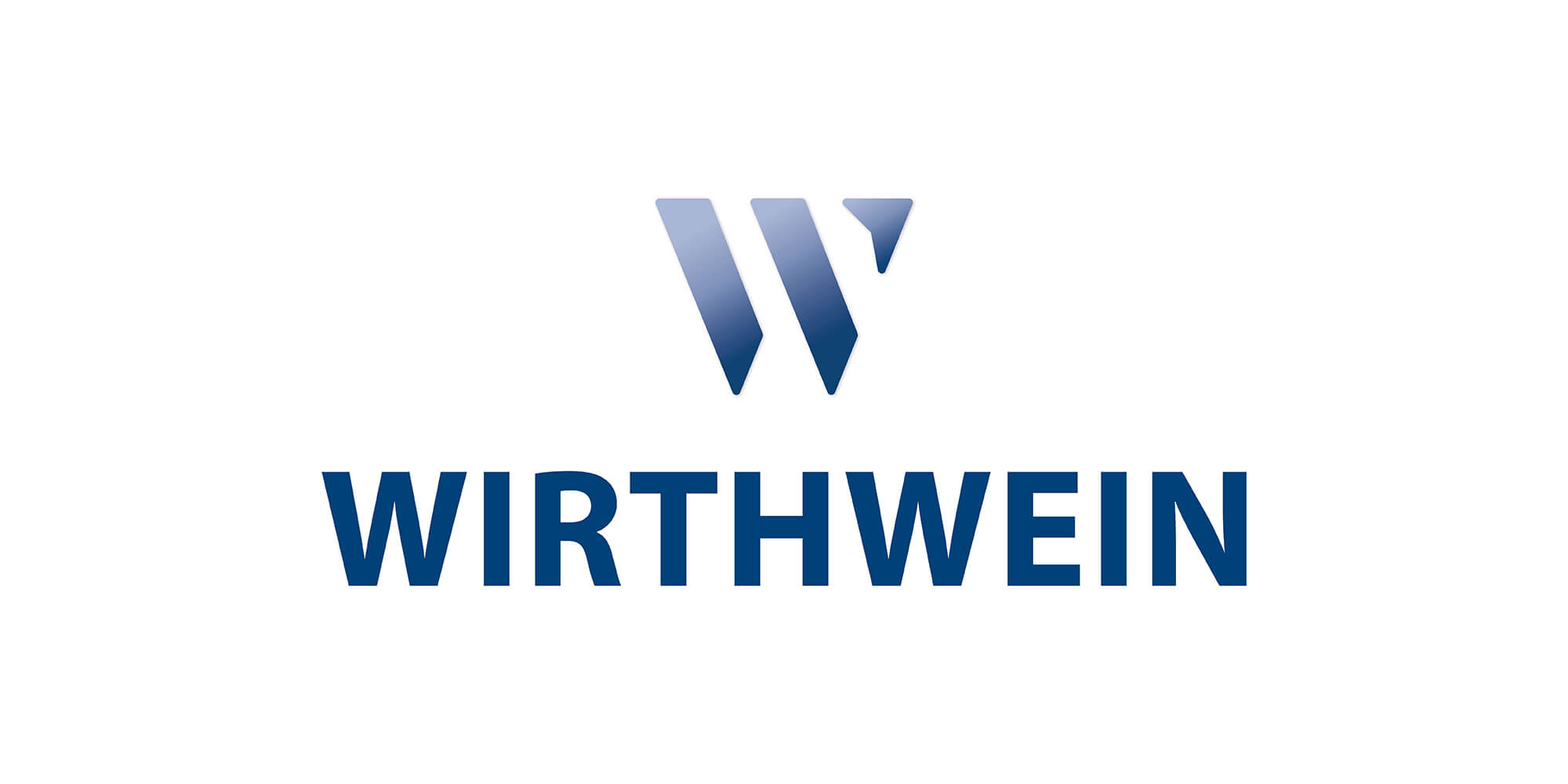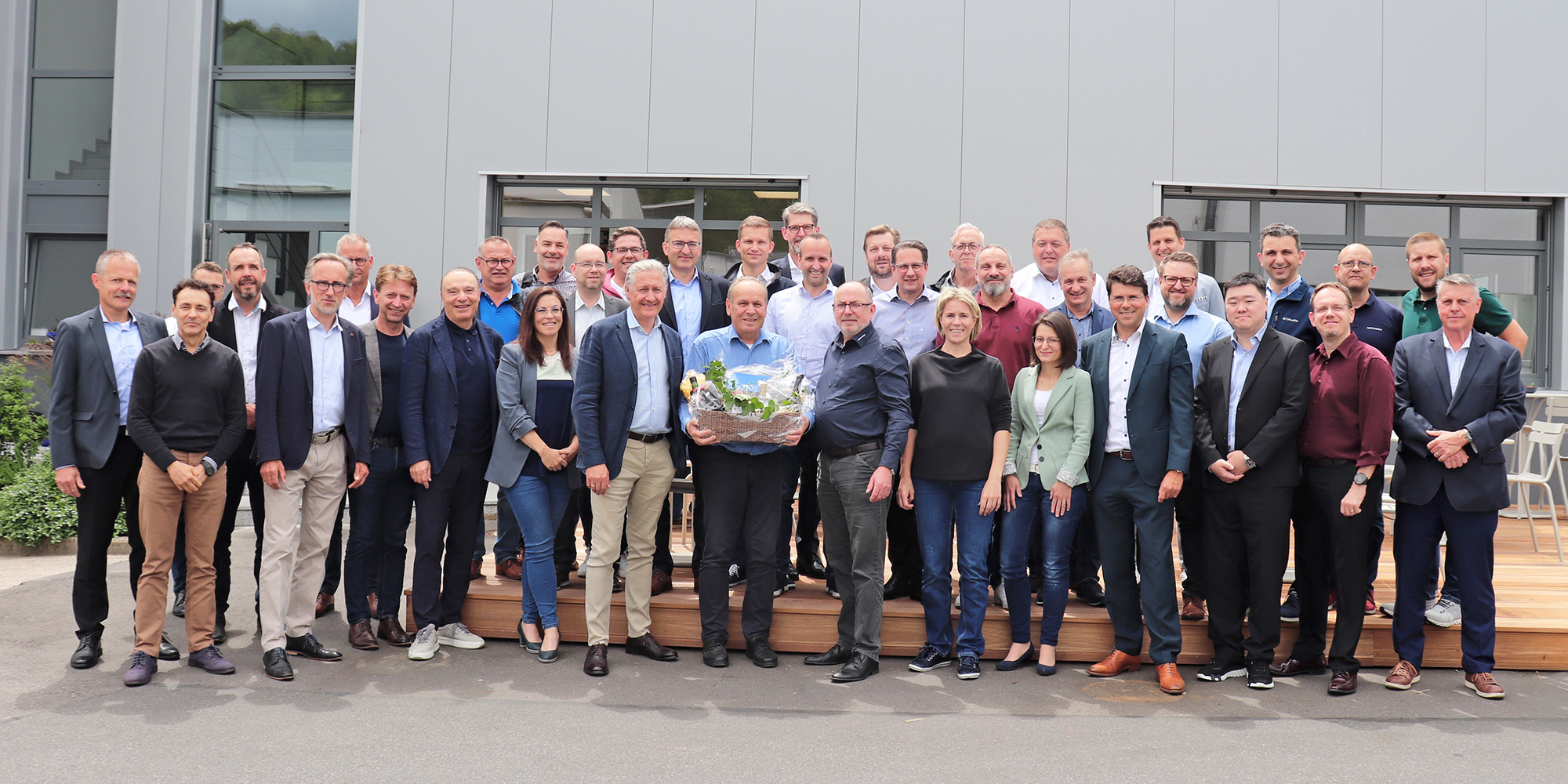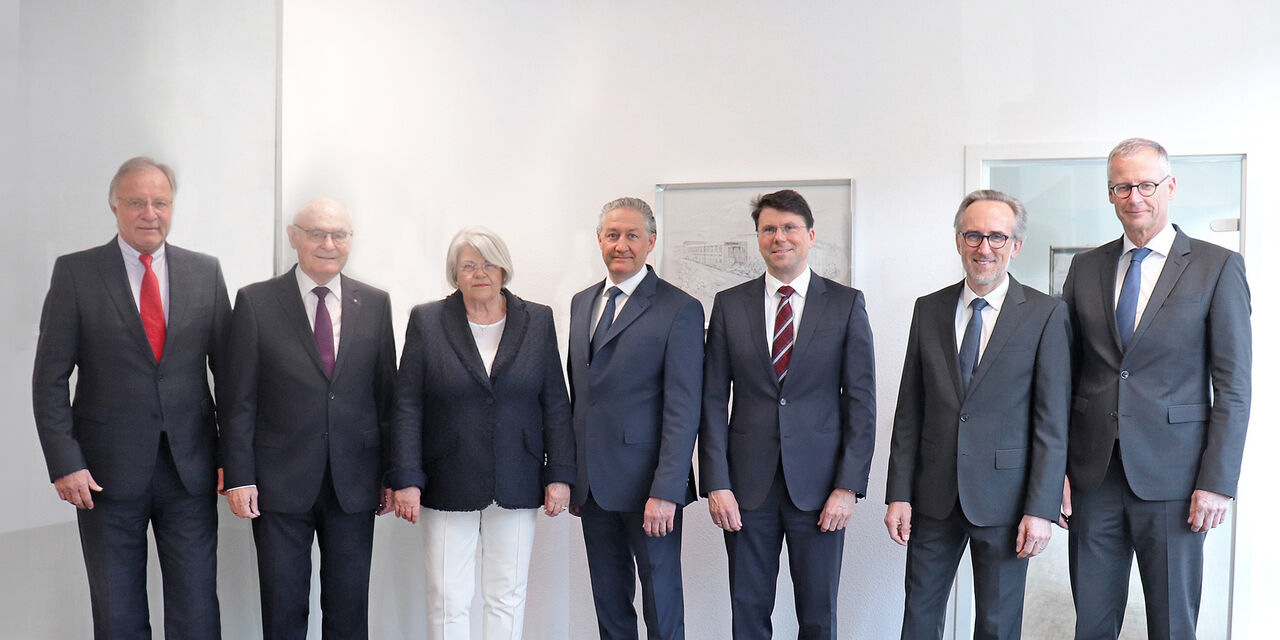Download the original article as PDF file
This article appeared in K-PROFI, issue 11-12/2021 and was written by:
Dipl.-Ing. Markus Lüling, Editor-in-Chief K-PROFI
How Wirthwein in Nauen establishes a ship-to-line delivery system for BSH Hausgeräte
In Nauen in the Havelland region west of Berlin, the then Bosch-Siemens Hausgeräte GmbH (today: BSH Hausgeräte GmbH) set up a production plant for white goods 25 years ago. As one of the most important suppliers, Wirthwein was also called upon to build up capacities for injection molding, especially of suds containers. Fence by fence, the plastics processor built its plant next to that of its customer. The intensive cooperation was further optimized in the summer of 2020: Wirthwein converts its in-house molded part transport to a driverless system, and a tugger train now delivers the suds containers directly to the assembly lines at the BSH site. Only a narrow slot remained for those responsible for the changeover. K-PROFI was allowed to look over their shoulders during the first weeks after installation.
A tub consists of two half shells: The lighter front part has a round recess for the filling opening. Bushings for the drive shaft are inserted and overmolded in the heavier and closed rear part. Therefore, two machines with clamping forces of 6,500 and 8,500 kN from KraussMaffei and Engel are in operation. The larger ones each have a supply station for the insert bushings. All the suds containers are made of polypropylene. Silo trains deliver these most diverse compounds to Wirthwein. The material is conveyed directly from the silo to the corresponding machine to be processed.
Conversion of supply logistics as an opportunity
Up to now, Wirthwein has supplied suds containers on special pallets measuring 120 x 120 cm, each containing 24 pieces, via shuttle vehicle. The linear removal robots of the injection molding machines stack the container parts onto the special pallets in a defined manner with an accuracy of max. 5 mm.
Against the backdrop of a planned new supply logistics system, BSH and Wirthwein jointly considered further optimizations that would also be reflected in cost reductions if possible. The end result was a concept based on two key measures: First, the introduction of an automated guided vehicle system (AGV) in Wirthwein's in-house logistics. And secondly, a ship-to-line concept with delivery of the suds containers via tugger train directly to the assembly lines, in conjunction with the elimination of the buffer warehouse at BSH in Nauen. In this context, new special pallets in the dimension 204 x 120 cm with 30 pieces each were implemented.
AGV instead of pallet transport system
Until now, Wirthwein had been using injection molding machines to manufacture on the 120 x 120 cm special pallets and transporting them along the outer wall of the production hall with the help of a common pallet transport system (PTS) for all seven machines (see illustration above left). "Converting the system, which was very modern at the time, to the new pallet dimensions was impossible. A completely new PTS would have been out of date and much more expensive than any other solution," reports plant manager Garri Genrich of the early considerations. In addition, Wirthwein wanted to get the forklifts even further out of production, which had previously brought empty pallets to the injection molding machines. "That's why we planned the dismantling to use the freed-up space for an alternative transport method."
After internally evaluating various concepts, those responsible decided in favor of an automated guided vehicle system. Among the AGV providers, Safelog from Markt Schwaben won the race with its concept. "This was an autonomous decision by the plant, albeit within a given budget," points out Klaus Seybold, Head of the Home Appliances and Electrical Industry Business Unit at Wirthwein. The project was managed by Jürgen Wilhelm, Head of Group Logistics at Wirthwein, and Nicole Mahnke, Industrial Engineer at the Nauen plant.
When the internal logistics were redesigned, the travel axes and, above all, the supports of the linear robots had to be taken into account. As a result, five injection molding machines are equipped with two pallet stations each and two with one pallet station each. Wirthwein designed the push and lift tables on the machines and in the station itself. The three autonomous, electrically driven Safelog AGV L1 transport robots can move omnidirectionally and are therefore very flexible. Four lifting columns are used to raise and lower the transport device with the pick-up points for the pallets. The AGVs each have a fixed "home base" under one of the pallet locations and charge their batteries there while there are no transport orders. The AGV station adjacent to the injection molding shop has seven substations.
In order to realistically test their operation with suds containers, Safelog set up driveways, pick-up stations and a station in a rented hall prior to the installation. Here, trial operation was simulated - with the series vehicles, empty and fully loaded special pallets, and the pallet pickups designed by Wirthwein itself at the transfer stations to the injection molding machines and in the station.
Reconstruction during the customer's production break
The reconstruction work in the existing building and on the seven existing machines included in the project was performed during ongoing operations in calendar week 30/2020, during which BSH temporarily stopped its assembly operations for a maintenance week. Key steps included the dismantling of the pallet transport system, the establishment of an intermediate manual operation to maintain production, and the installation of the new AGV.
To optimize the utilization of space, the production pattern of the seven machines was also tightened and two machines were moved slightly. In fully automatic operation, one container part per machine per hour is automatically separated as a QA part via conveyor belt. In the days of the modification, this manual discharge path for QA and defective parts was also used to transport regular production. With the modification, Wirthwein also installed a new WLAN illumination system to ensure internal communication between the AGVs. The vehicles come with sensor-supported, automatic detection of people, machines and vehicles in the movement area.
Own performance as a leap of faith for the own team
"The biggest challenge was neither the mechanics nor the moving of the machines, but the programming of the interfaces and the IT linking of the production systems," Garri Genrich reports the experiences of the first days. After all, interventions in the communication structure and in all machine controls were necessary, the communication of each machine with the conveyor system had to be adapted, and the AGV had to be integrated vertically and horizontally into the IT systems.
The biggest surprise for him was the discovery of "hidden talents" among the employees: "Being allowed to do most of the work ourselves is considered a leap of faith by the workforce. Much of the work on machines and fixtures as well as the safety control system could well have been contracted out to the machine manufacturers or the AGV supplier, but "we wanted to do a lot ourselves. In the end, we have to be able to master our system in regular operation. Then it's good not to have to call a service department at the slightest problem. And that's despite the fact that the system here is not completely ready-made." The automation technology team at the Nauen plant managed by Danny Schmidt worked very closely with the Safelog technicians to ensure sophisticated control and communication between the systems.
Ship-to-line instead of shuttle traffic and buffer storage
Directly opposite the AGV station with its seven substations is a pallet flow storage system. Forklifts, which have been equipped with 70 cm longer tines because of the larger pallets, take the loaded pallets from the station and lift them into the specified tunnel of the buffer store. The entire storage rack is inclined to the rear and equipped with free rollers and brake rollers in such a way that the pallets line up at the rear removal position without further intervention. The buffer storage is necessary in order to be able to react quickly and flexibly to all customer requests and changes in quantity, even at short notice.
While the AGV is a reactive system that works without an interface to the ERP system, the SAP Warehouse Management (WM) is indispensable for warehouse management. It regulates loading and unloading from the storage system and observes the necessary maturing time of the suds containers. With the support of the SAP WM team from the headquarters in Creglingen, this challenge was also mastered well.
Previously, Wirthwein had used a special truck adapted to the pallet size to shuttle to a rear docking station at BSH, where the pallets filled a small buffer store (see illustration above right). Forklifts then moved pallets to the assembly lines as needed. Today, the tugger train from Still with four trailers equipped at Wirthwein delivers trolleys with preassembled pallets directly to the two BSH lines in the correct sequence (illustration below right). For each assembly line, one trolley is loaded with front parts and one with rear parts of the suds containers. The tugger train runs in a delivery cycle harmonized with the production lines and brings the trolleys with empty pallets from BSH and picks up loaded ones. The tugger train system has an extremely tight turning circle. In the first few days after commissioning, the logisticians and forklift drivers optimized the route and the parking positions for unloading and loading.
Expandable and adaptable logistics concept
The AGV and the concept of the tugger train are not bound to the suds container project at BSH, but can be expanded and reused in many ways - at all plants. Only the receptacles designed for special pallets and the programming had to be adapted. "It was a particular challenge to implement the new logistics concept with seven machines within the very short time window available," points out Garri Genrich, "but in terms of forklift freedom and occupational safety, the AGV is the best solution". Klaus Seybold believes that the pilot project is also interesting for other plants, because Wirthwein operates another fence-to-fence plant in addition to Nauen, as well as a shop-in-shop model for or with BSH in Poland, and another shop-in-shop model in the railroad technology business unit for a Chinese customer.
In his quest to create more value for Wirthwein, Klaus Seybold is always in search of new products and processes that can be adopted by transferring knowledge from one plant to another. For him, it is quite possible that the now experienced employees from Nauen will accompany an AGV introduction at another Wirthwein plant. "The fall months are the ones with the highest sales of white goods," reports Klaus Seybold. "This is a big challenge every year, and a particularly exciting one this year with the introduction of the AGV."
Garri Genrich hopes to receive orders from a new automotive customer in the medium term. In any case, space is available for additional machines to injection mold automotive parts in Nauen - also as a result of the reorganized production of suds containers.
Wirthwein Nauen in profile
Wirthwein Nauen has been in operation since 1996. Initially designed exclusively to supply BSH with products for white goods, the automotive industry was added as a second business unit in 2006. The main product of the plant with a total of 150 employees continues to be plastic components for home appliances, and BSH continues to be the main customer in Nauen. A total of 21 injection molding machines in the clamping force range from 3,500 to 16,000 kN and a focus between 6,500 and 8,500 kN are distributed over one bay for the production of home appliance parts and one bay with automotive interior parts. Seven of the 21 injection molding machines produce the two halves of suds containers. The main automotive engineering products are door modules for passenger cars and light trucks, some of which are also foamed and finished after injection molding. The plant processes around 9,000 t of plastic per year and is mainly supplied by seven double-chamber silos with 25 t per chamber, six of which are designed for PP and one for polyamide.
BSH Hausgeräte in profile
BSH Hausgeräte GmbH is a global leader in the home appliance industry with sales of around 13.9 billion euros in 2020 and 60,000 employees. The Group's brand portfolio includes eleven well-known home appliance brands such as Bosch, Siemens, Gaggenau and Neff, as well as the ecosystem brand Home Connect, and various service brands, including Kitchen Stories. BSH produces in 39 factories and is represented in around 50 countries. At its Nauen plant, BSH Hausgeräte GmbH has been successfully producing premium washing machines for the global market since 1994. BSH is a company of the Bosch Group.




